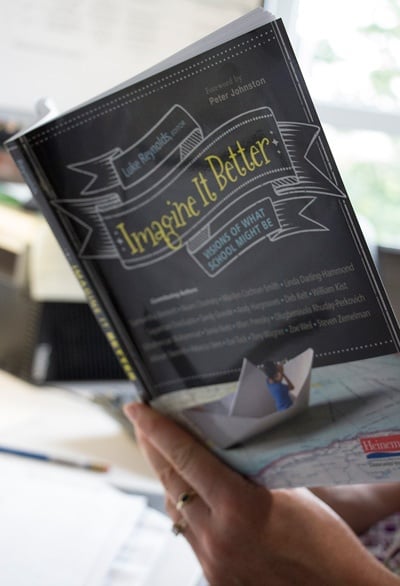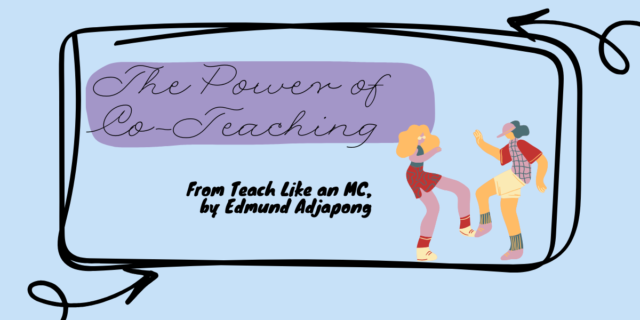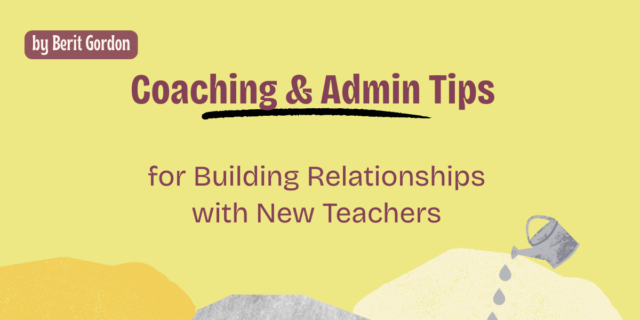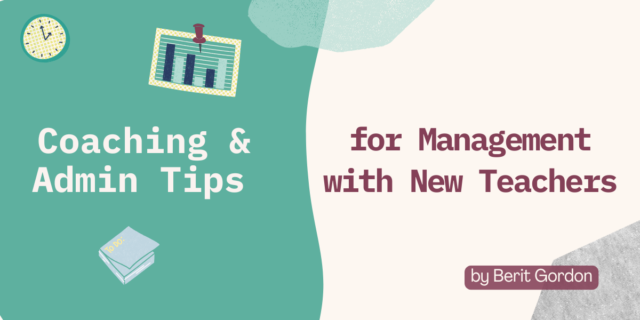
Author Luke Reynolds has taught middle and secondary English in public high schools in Connecticut and Massachusetts. Luke’s new book “Imagine It Better: Visions of What School Might Be” features 18 provocative invitations from some of the most brilliant and creative minds in education today, including Tony Wagner, Andy Hargreaves, Noam Chomsky, and Linda Darling-Hammond. The book focuses on the present tense of school reform: what you can do to improve the instruction in your classroom and school today. Each essay tells a story of what can be—with the heartbeat of imagination and a fresh vision of possibilities.
In his introduction, Luke writes how his hope for transformative action led to Imagine it Better.
Introduction written by Luke Reynolds
It's day eleven of the government shutdown. I drive through a national park to go to work each morning, so I don't have to check the news to see whether the government is up and running yet. I just look out my car window and see the orange cones still blocking the entrances to the parking lots. The shutdown is akin to a potent virus for which we've yet to find a vaccine. We stop imagining what could happen and start judging one another for what hasn't happened. We're quick to point our collective finger at everyone else rather than ask what we might be able to do together.
 In education, we see some of the same paralysis that comes from intense judgment and evaluation. As soon as we think one person, one school, one professor, one business leader, one billionaire, one researcher, or one organization has "the answer,"we all too quickly begin criticizing and critiquing everyone else. We see scarcity, failure, and strife instead of possibilities for transformation.
In education, we see some of the same paralysis that comes from intense judgment and evaluation. As soon as we think one person, one school, one professor, one business leader, one billionaire, one researcher, or one organization has "the answer,"we all too quickly begin criticizing and critiquing everyone else. We see scarcity, failure, and strife instead of possibilities for transformation.
Shutting down is the exact opposite of our goal as educators. We walk into our classrooms each morning hoping that openings will occur. We hope that our students' minds will open to new possibilities, views, ideas, opportunities, skills, and challenges. We hope that our own hearts will be more open to caring, investing, believing -again- that what seemed impossible yesterday will be obtainable today. We hope that our schools will flourish as places of joy and creativity and challenge and – yes – imagination.
Lewis Hyde, in his poignant and remarkable book The Gift (2007), provides a scathing critique of a society that builds itself on principles of shutting down, of scarcity and insufficiency. He writes, "The market-industrial system institutes scarcity, in a manner completely unparalleled and to a degree nowhere else approximated. Where production and distribution are arranged through the behavior of prices, and all livelihoods depend on getting and spending, insufficiency of material means becomes the specific, calculable starting point of all economic activity" (28).
We need to think seriously about the purpose of our schools in this context. Is public education also built on the ideals of a market-industrial system, complete with economic justifications? Or are its intentions deeper, more complex, more fulfilling to both the self and to society? By narrowing conversations of educational purpose to pathways of progress via test scores and standardization alone, we move toward production and distribution. We quantify inputs and outputs and try to increase the rates of these inputs and outputs as if human connection and growth can be reduced to an equation.
The writers of the essays in this book reject simple equations and productdistribution mindsets. Instead, they are re-envisioning possibilities. They are not interested in profits – in "getting and spending" – but rather are empowered by the goal of improving the lives of students, teachers, and society at large. What if instead of beginning with a scarcity mindset that causes students, teachers, parents, administrators, and others invested in education to shut down, we start with an imaginative mindset? What if we imagine education as we want it to be, remembering that education is, at its core, about people and relationships, not about "getting and spending"?
Diane Ravitch (2010) powerfully warns that "the schools will surely be failures if students graduate knowing how to choose the right option from four bubbles on a multiple-choice test, but unprepared to lead fulfilling lives, to be responsible citizens, and to make good choices for themselves, their families, and our society" (224). If we always begin with blame over test scores and chastisement about what our tax dollars are "getting" us as a society, we will be lost in a perpetual cycle of scarcity. We may enable students to score better on bubble tests, but the goal of guiding them to lead fulfilling lives and creating a responsible, just society will recede farther in our rear-view mirror. We need to return to the elemental questions, imagine how school could be – what we want school to create and what we believe it should do – and propose the most inspired and inspiring ways to achieve these possibilities.
This goal recognizes the structural inequalities inherent in a system of education that is based on "getting and spending," one that views success as correct answers rather than authentic growth, social equality, and transformation. Asking one another to re-envision what we expect of schools is not easy, and there is a layer of privilege in even having the time and resources to pose these kinds of questions. Yet there is a great responsibility to do so, lest our privilege march onward toward profit and even oppression. If we take seriously the call to educate students, we need to imagine how knowledge can be viewed differently, how we can create it differently, how we hear it, explain it, share it, and – especially – how we count it.
Poet Mary Oliver (1998) asks a hard question that deserves an honest response from educators, administrators, and policymakers: Listen, are you breathing just a little, and calling it a life? We can blame and criticize one another, point fingers, and advocate for a thousand mini-shutdowns throughout our educational system. Or we can start imagining other possibilities and share those possibilities in ways that empower and inspire. We can work toward re-envisioning what counts as knowledge and forge new paths rather than walk those dictated by market-industrialism.
Just as one rain shower will not grow a field of flowers, one person or group will not devise a plan that transforms our educational system perfectly. But if we can learn to offer ideas grounded in imagination, grown with hope, and empowered by action and belief, we will be well on our way toward creating something new. As Hyde tells us, The passage into mystery always refreshes. If, when we work, we can look once a day upon the face of mystery, then our labor satisfies" (25). It is time for us to be refreshed by diving into what could be, and in order to do so we must tell Scarcity and Status Quo that their time at the table of education is through. We need to invite Imagination to sit with us, knowing full well that while things might get messy, these ideas will lend strength to our hands and freshness to our ideas: our labor will deeply satisfy.
Out of this hope for and commitment to transformative action comes the book you hold in your hands. From Sonia Nieto's poignant and insightful assignment asking her students to explore what makes an ideal school to Marilyn Cochran-Smith and Rebecca Stern's exploration of inquiry as a remarkable and eye-popping way to gaze on the world, our students, and ourselves to Samantha Bennett's humorous andprofound exploration of collaboration and coaching throughout a school district, each essay is a story about what could be and each story has the heartbeat of imagination. The authors here are seeking to go beyond describing the past or repeating the present; they are willing to look deeply into Hyde's mystery to describe something we can't quite yet see and sometimes we can't believe could ever exist.
What is required of us in this moment is to open up, not shut down. We need to look honestly and reflectively at ourselves, our public education system, and our means. Instead of viewing each with a scarcity mindset bent on highlighting failures and worshipping bubble tests, we need to focus on the overwhelming surplus that is – right now – part of public education. In what specific ways do authentic human connections lead students and teachers to incredible growth? How do empowering, justice-oriented teaching methods transform classrooms? In what ways can – and do – classrooms create new cultures and possibilities rather than recapitulate old ones? And how do we close our ears to the numbing refrain of criticism and fear so we can see with fresh vision the incredible human capacity for transformation before us?
The essays in this book do just that.
References
Hyde, Lewis. 2007. The Gift. New York: Random House.
Oliver, Mary. 1998. West Wind: Prose and Prose Poems. New York: Mariner Books.
Ravitch, Diane. 2010. The Death and Life of the Great American School System. New York: Basic Books.
Imagine it Better is out today. To read a sample chapter for Imagine it Better click here.


